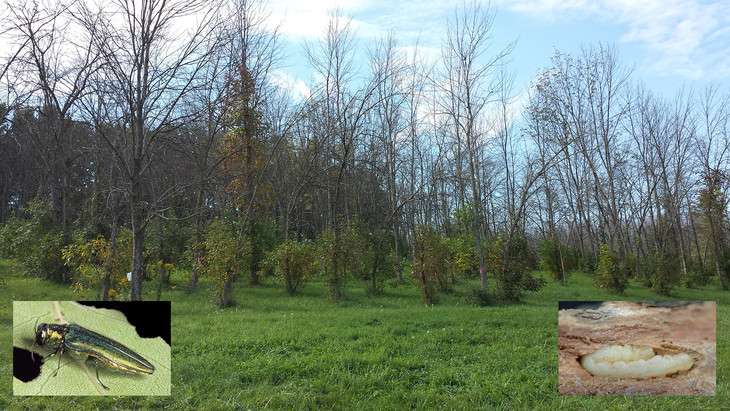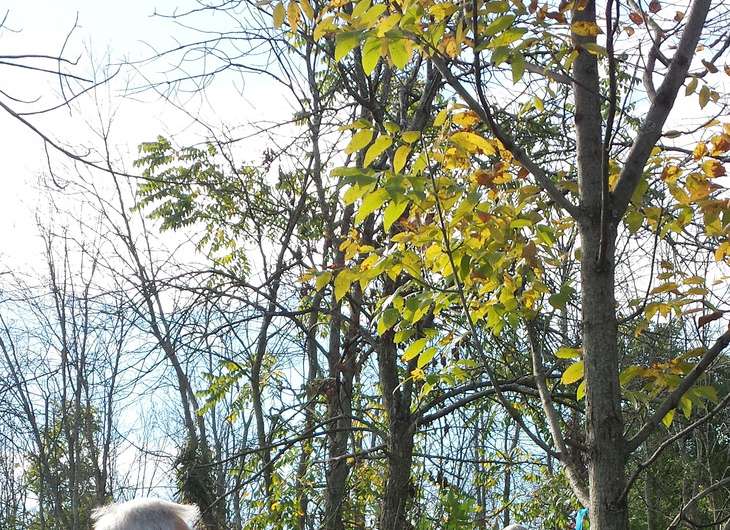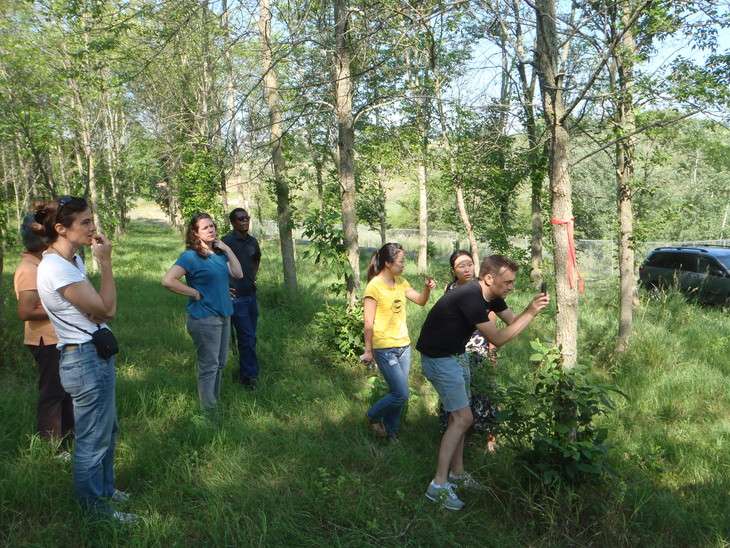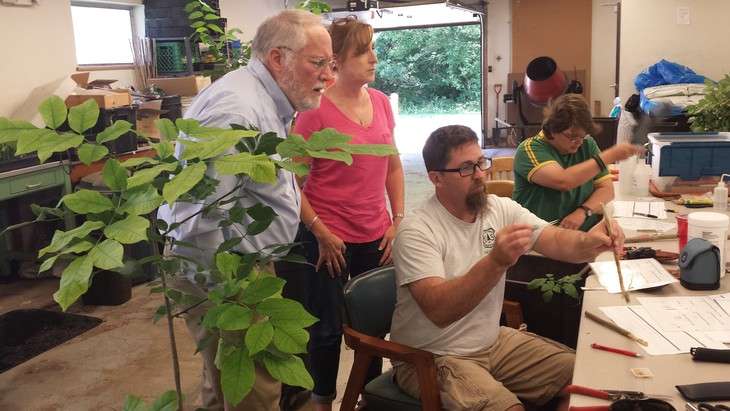Geneticists on cutting edge of effort to save ash trees

When Kim Steiner created an ash plantation on the edge of Penn State's University Park campus in 1978, few Americans thought about "climate change," no one had heard of the emerald ash borer, and the Yankees beat the Dodgers in the World Series, swinging primarily bats made from ash.
For ash trees, those surely were the good old days.
The professor of forest biology in the College of Agricultural Sciences, who is also now director of The Arboretum at Penn State, had collected seeds from wild green ash trees in 27 states and Canadian provinces in the fall of 1975. He grew the seedlings for two years before methodically planting 2,100 of them, all 12 feet apart, in a seven-acre plot.
Steiner was conducting a provenance trial, also called a common-garden test—basically moving trees that had evolved in different climates to one location and carefully monitoring their growth and other characteristics. The goal was to understand how species adapt to their environments. Fortunately, in the last few decades, the plantation was maintained because of the opportunity it provided to study the effects of climate change on trees.
"I knew that I couldn't get everything I wanted when I sent out two graduate students with funding on a two-week swing through the Midwest and South to collect seeds in wild populations of green ash," he said. "So I also mailed hundreds of letters to federal and state forestry employees, park supervisors, fellow scientists—anyone I could get a name and address for—asking for help in collecting ash seeds from local wild populations."
It turns out that the little-known ash plantation off of Porter Road near the University's Swine Research Facility—the largest collection of green ash germplasm in one location in the world—likely will play a significant role in saving the species, which is being decimated by an insect from Asia.

The emerald ash borer, often referred to as EAB, is a half-inch long, metallic green, wood-boring invasive insect that feeds exclusively on ash trees. EAB larvae feed under the trees' bark, and they eventually girdle and kill trees within four years of infestation. They first were identified in North America in Michigan in 2002 and showed up in Pennsylvania in 2007.
The borers have killed tens of millions of ash trees across North America, and their devastation is so complete that forest scientists worry they will essentially wipe out our native ash species, all of which appear to be susceptible. Highways through much of the mid-Atlantic and Midwest regions are now lined with the skeletons of dead ash trees.
In Penn State's ash plantation, in forests across Pennsylvania and in a growing portion of the East, the emerald ash borer is killing nearly all ash trees. The relatively few that survive or escape—"lingering ash trees," as scientists are calling them—may hold the key to rescuing the species, and Penn State tree geneticists and other forest scientists are focusing on them.
"As of this fall, 95 percent of the trees in the plantation that were alive before EAB are now dead, and most of the rest will be dead next year. It is amazing how devastating the emerald ash borer is," Steiner said. "But we have about 15 trees remaining that show little or no die-back from EAB—they look pretty healthy, and we know that most of them have been attacked because they have exit holes where the adults have emerged after feeding on the inner bark."
Steiner explained that he is interested in whether some ash populations represented in the plantation are less preferred by the emerald ash borer as indicated by the speed with which they succumbed to the infestation. Current thinking is that every tree eventually will die under heavy and persistent EAB infestation, but any level of genetic-based resistance could be something to build upon to save the species.
"We believe we are seeing that, but more analysis needs to be done," he said.

Penn State molecular geneticist John Carlson is looking specifically at the genetic mechanisms by which surviving trees might be battling the insects. He and Steiner have been talking with officials in the Pennsylvania Department of Conservation and Natural Resources Bureau of Forestry about saving white ash and green ash in the state by preserving and propagating lingering ash trees remaining in the Penn State ash plantation, on state forest lands and in private forests.
"Some trees were left that appeared very healthy with good canopies and not very many EAB exit holes," Carlson said. "So those represent potentially resistant genotypes. There are definitely some biochemical or genetic responses—it's an indication of some genetic basis to tolerance in the trees. There have been previous molecular studies comparing lingering versus fully susceptible green ash trees treated with EAB larvae."
He noted that Jennifer Koch at the U.S. Forest Service Laboratory in Delaware, Ohio, has collected cuttings from many lingering trees after infestations and has developed a bioassay in which the cuttings are inoculated with eggs from EAB, and the growth of the larvae is assessed. Some of the tolerant trees slow or reduce growth of the larvae; some actually seem to kill the larvae.
Material from all the ashes in the plantation has been collected and is being tested in Carlson's lab in search of a basis for genetic resistance, and the genomes of those trees that are left are being sequenced. The genomes of very susceptible trees also are being sequenced so they can be compared to see differences at the genome level that show resistance or potentially tolerant trees.
Determining whether lingering trees are resistant to new infestations will take years, and Steiner and Carlson have offered Penn State's help to the Pennsylvania Bureau of Forestry and the U.S. Forest Service in setting up at least one grafted seed orchard that contains material from lingering ash trees that have survived EAB infestations. Then as time goes on, Penn State would assist in evaluating those trees for their level of resistance and develop a seed orchard of resistant trees.
"We're hoping that the state will work with us on creating a seed orchard because we don't have all the resources we need to do that. This is an issue that is going to continue to increase in importance and severity because there will be more frequent introductions of exotic pests and diseases going forward," Carlson said.

"We need to develop collaborative, integrated approaches to dealing with these, rather than just giving up on a species like ash," he added. "We need people out in the field looking for trees that may be resistant to the different stresses that they're facing."
As for the future of ash baseball bats, the plight of one iconic brand illustrates the ash's predicament. For more than 100 years, Louisville Slugger, the official bat of Major League Baseball, has sourced its white ash from a relatively small area of northern Pennsylvania and New York. Now the emerald ash borer is invading the company's harvest site.
"The bottom line is that those forests that Louisville Slugger uses to harvest ash and make high-quality bats are being devastated by emerald ash borer over time," a company spokesman said recently. "It affects the heritage of the American ash tree and Louisville Slugger products."
Coincidentally, Steiner was in Louisville this fall and visited the Louisville Slugger factory. "They are still making ash bats, but that will not last long," he said. "The resource is rapidly disappearing."
Provided by Pennsylvania State University





















